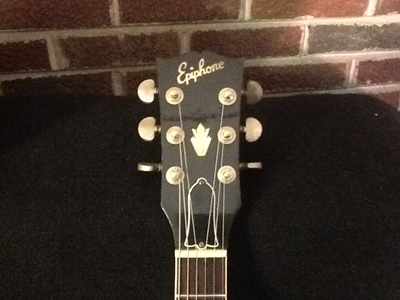
A couple of months ago, I received a call from a friend who runs a drum shop in Southern Illinois. He’d taken in a guitar on trade-a semi-hollow electric Epiphone was as much as he could tell me-and he needed help figuring out exactly what it was. Always up for a good guitar mystery, I eagerly accepted his request for help, and as I waited for the guitar to arrive, I began to speculate on what it might be. Maybe it was an MIJ thinline, or even a 60s Casino, ala John Lennon. My excitement grew.
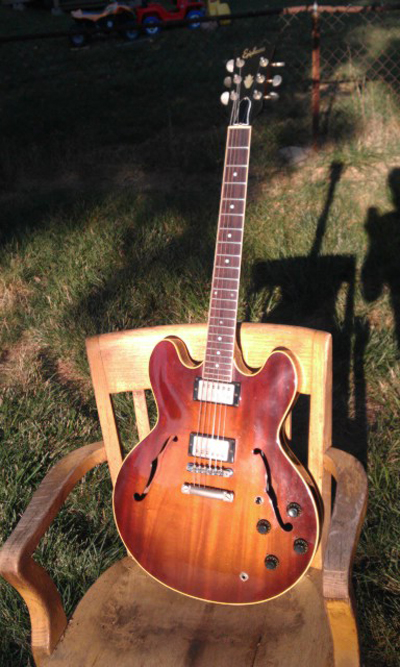
Mystery Ephiphone Guitar: Prototype or Custom Build?
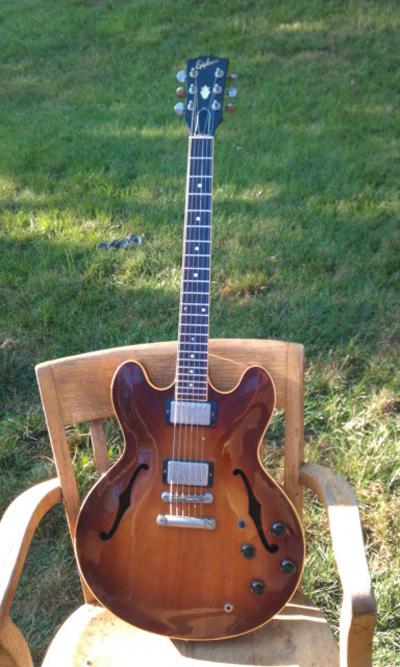
Mystery Ephiphone Guitar: Prototype or Custom Build?
The guitar was delivered a few days later, and I ripped the box open like a kid on Christmas morning. With packing peanuts flying, I pulled out a hard shell case that could have housed a 335. Inside the case was a label-less, serial number-less semi-hollow electric guitar with Epiphone on the headstock, just like my friend had described. The guitar looked and felt like it was USA-made, but I needed to examine it more closely.
I noted the guitar’s Grover tuners, and the nut looked original and to Gibson spec. The brand was inlayed like a Gibson, with the finial in the center, which is typical of a standard 335. I also noticed what I call “ears” on the headstock, which occur when Gibson cuts the neck blanks for their guitars and then reuses scrap pieces by gluing them to the headstock portion of the blank, creating laminate lines that can be seen on the back of the headstock. The neck and heal were made of mahogany, with no laminate joints, and the fret board was rosewood with dot inlays. However, the headstock had no serial number, no volute, and no stamp to indicate that it was USA-made.

Mystery Ephiphone Guitar: Prototype or Custom Build?
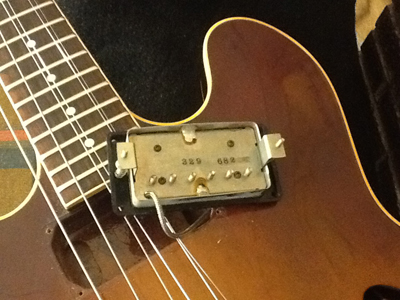
Mystery Ephiphone Guitar: Prototype or Custom Build?
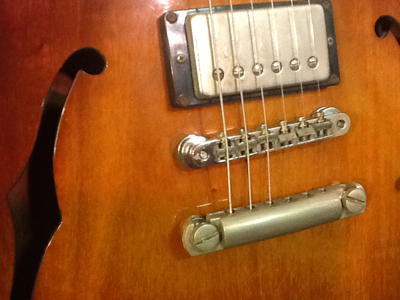
Mystery Ephiphone Guitar: Prototype or Custom Build?
The body of the guitar appeared to be a laminate mahogany top, back, and sides-not maple, like a typical 335- with a subtle, tobacco-burst, nitro lacquer finish. The bridge was a Gibson-stamped ABR Tune-o-matic, and the wiring was braided like a Gibson as well, but I could find no label or markings inside the f-hole.
Since I was having a hard time dating the guitar without a serial number, I decided to remove the electronics to get a look at the pots, switch, and pickups. Tone and volume potentiometers typically have a series of numbers on them that identify the manufacturer and the production date. Unfortunately, these pots were liberally covered in solder, which made the numbers completely indiscernible. The pickups, however, did offer me a clue.
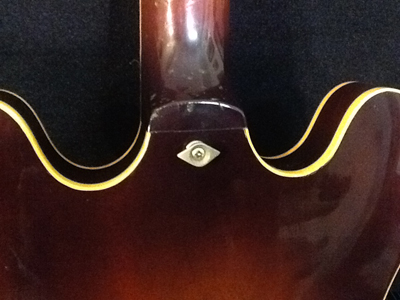
Mystery Ephiphone Guitar: Prototype or Custom Build?
In 1980, the Norlin Corporation began to take the first steps toward production of a reissue Les Paul guitar, and they assigned engineer Tim Shaw the task of reproducing a PAF-style humbucker for the project. Due to financial constraints set by Norlin, Shaw could only approximate certain aspects of the original pickups, but the final product was a PAF-style pickup that was superior to the pickups that Gibson was producing at the time. Tim Shaw pickups are easily identifiable because they have a separate, ink-stamped series of numbers on the bottom that indicates the type of pickup (bridge or neck), as well as the date of production. The pickups in question were stamped 329 682, which revealed that the production year was 1982.
I was looking at an Epiphone-branded, Gibson-made, USA-manufactured 335 with no serial number and no label, but with pickups that gave me the guitar’s production year. My conclusion was that the guitar must have been either a prototype, or maybe a personal build for someone who worked for Gibson at the time. Either way, my friend had himself a great playing and sounding instrument, and I’d had fun doing the detective work.
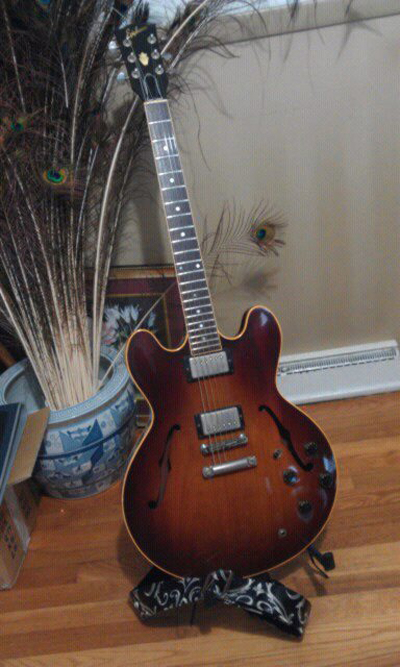
Mystery Ephiphone Guitar: Prototype or Custom Build?
Written by: Dave Anderson

Wow! Everything about that thing says “Nashville” to me. Interesting that it has a laminate mahogany body? What was the point of that? Looks like it has neck binding too. Do the plastic nibs cover the ends of the frets? I am assuming so. I have never seen that logo anywhere. Nuts man, good snag.
I think I’m in love. I also have a strong appreciation for the unusual and i’d rather have that than a new Gibson 335.
I’m dying to know how much he traded for that (essentially, what he “paid”).
Mike, I think this might be a pre-production Sheraton. I vaguely remember seeing a similar instrument marked Sheraton in the mid-80’s, and the overall package sure looks like my ’91 Sheraton…..
First of all,the very first clue would be that this has an Gibson Headstock, not an Epiphone. All of the markings scream Gibson so I figure this is an experimental custom build to see what they could produce on a limited budget. I’d pay handsomely for this guitar because it is most likely a one off. Good job reearching the pickups and indeed it shows it was manufactured (the pickup) in ’82 but this may not be true with rest of this fine axe. A little prodding from Gibson themsleves may yield more info on this instrument.
In the meanwhile, can I have it just because I’m a faithful reder? LOL
Very interesting specimen. I believe most makers don’t allow employees to put the brand name on personal instruments, so maybe that possibility can be ruled out. Was Gibson using Grover Rotomatics at that time? My initial reaction was that they must be replacements. The bound fingerboard is another elegant touch. Good detective work!
Beautiful guitar, but (and I’m no vintage guru) I would hesitate to call this a true Epi or Gibson. Too many things just don’t look kosher: the shape and size of the Epi logo, the color of the finish, the control layout, the mounting of the strap button. I would guess a Japanese mash-up semi clone of some sort?
All I can possibly suggest is that it is a Swedish import ,in the 90’s they used the Gibson headstock with the inlaid epiphone but mostly on acoustics , they would read epiphone by Gibson
That headstock/logo looks a lot like the same ones used on the Epiphone “Spirit” models…
This Epiphone looks superb, I’ve just stumbled on another one from the same era possibly on eBay. It’s an odd take on the SG Junior.
http://www.ebay.co.uk/itm/VERY-RARE-1982-CHERRY-EPIPHONE-SG-JUNIOR-Made-in-USA-in-excellent-condition-/121008587020?pt=Guitar&hash=item1c2cac810c
I agree that this guitar is either a prototype or a custom one-off. In 1982, Epiphone produced the American series (Spirit, Special & Map guitar) in Kalamazoo. These were meant to be lower budget, American-made guitars to compete with the higher quality Japanese imports…though, extremely high quality for the Epiphone brand. They had the same open-book headstock, two-screw truss cover and scroll Epiphone logo as this 335. Most likely they had nitro finishes as well. After poor sales, they moved production to Nashville to produce them as Gibsons and rebranded the remaining Kalamazoo-made guitars with a Gibson decal over top of the original Epiphone logo. There were several other one-off prototypes that came out of Kalamazoo during that time period as well.
Paul, the SG that your linked to is also from the American Series circa. 1982. Very nice find!
Jim, the “Epiphone by Gibson” models were early Korean (1986-1988). I think that the imports you may be thinking of were the Bohemian-made Epiphones from the Czech Republic. They were very high quality and also short-lived. The only imports that I am aware of with a Gibson heastock were 1989-1990 Korean (Samick) guitars that were produced directly after the “Epiphone by Gibson” models. There were a couple of cross-over guitars with both the “Epiphone by Gibson” logo and a Gibson headstock. The SQ-180 was one of them. The only other Epiphones with a Gibson headstock, that I am aware of, were the Japanese Domestic Market guitars from the 1990’s – mid 2000’s, which included some standard-run models, the LQ Series and the Japanese-market (only) Elite/Elitists. Though, these were not actually imports because they were made exclusively for the Japanese market. Although, quite a few have made their way across the globe.
hi my name is chip i am from salem mass. you had mentioned youre epi as being a proto. I was given given a gibson ES340 in 1994. i have had hard time finding out the exact year. this guitar was owned by my uncle but he has since passed away so i have very little info as to when it was purchased. i myself worked at daddy’s junky music…a kick ass used dealer…..sorry to say daddy;s went out of bussiness. iworked with two of the company’s vintage experts and they just could not pin point the exact production date. Like youre epi the pots were no help all i can tell you is that it has all it’s original parts. my friends at daddy’s did tell me that it could be a prototype.So i was wondering if you could help me out . all i can tell you is this is one beautiful guitar it is walnut and the neck was laminated to match the body.It is listed as excellant condition. I also aquired GIBSON FALCON AMP wich i just finished restoring any insight you may have would be deeply appreciated. Thanks
Epiphone didnt make “Prototypes” that was strictly a gibson marketing strategy to sell guitars off price…the Spirit and Special were manufactured in USA in 1982/3 and used Shaw pickups and Gibson parts-this was a short lived attempt prior to going to Japan in the early 70’s….
Hi, anyone recognise this make? It’s a dump find! , I have restored it now and is being checked over by a Guitar specialist. But no one knows who made it or the age.the only clue is epiphone pick ups and three way switch, there are only two pots, the head stock is a strange shape and the truss rod cover !, there is a four screw back plate with with the first two numbers starting. 22.. see pics. HELP!!. Flicks.
I have a Epiphone Doublecut Les Paul with a Gibson style headstock too, Ive been trying to figure it out , although It does have a serial number ,so I guess I will lokk that up next !